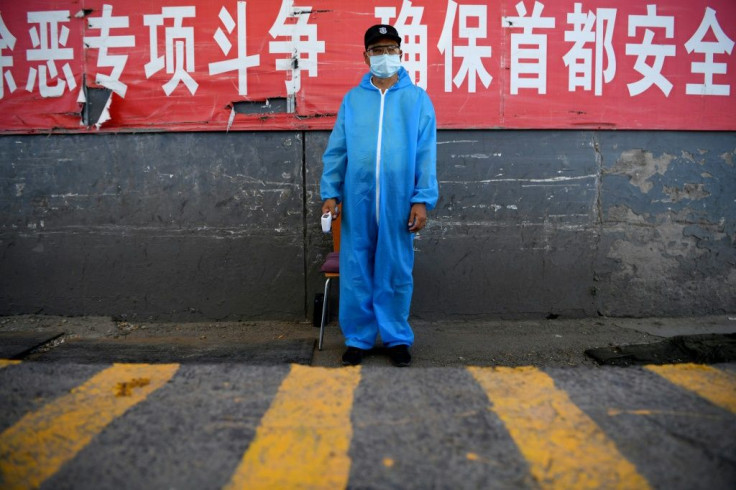China Coronavirus Second Wave: New Cases Surge As Beijing Adopts 'Wartime Emergency Mode'

KEY POINTS
- Beijing has confirmed 79 new COVID-19 cases since June 11 after going coronavirus free for 56 straight days
- The sudden COVID-19 attack has seen the local government impose "wartime emergency mode" on the district where the outbreak began
- “Beijing will not turn into a second Wuhan," vowed one top Chinese doctor
Beijing, the world's most populous city with 21 million inhabitants, on Monday saw 36 more confirmed COVID-19 cases to add to the 36 reported Sunday. The spike means Beijing has confirmed 79 new cases since June 11. The unexpected flare-up -- which is sparking fears of a “Second Wave” in China -- comes after the city had remained coronavirus free for 56 straight days.
The Beijing municipal government and the Beijing Health Commission (BHC) both linked the discomfiting new outbreak to the Xinfadi market, the most important wholesale food market in Beijing and located at the southwestern Fengtai district. The market, which is now shut down, is said to supply some 80% of the city’s vegetables and meats. Beijing authorities are reassuring city residents the market’s closure won’t lead to food shortages, rationing or huge spikes in food prices.
“The risk of the epidemic spreading is very high, so we should take resolute and decisive measures,” said Xu Hejiang, a spokesman at the Beijing city government Monday. Xu also called the new cluster "an extraordinary period."
The danger the outbreak might spread rapidly was reaffirmed by vice premier Sun Chunlan, who said the risk of the latest outbreak spreading was "very high." According to state news agency Xinhua, Sun noted the market's dense and highly mobile population as the reasons for this assessment he made during a meeting of the State Council, China's cabinet, on Monday.
Of the 36 new COVID-19 cases on Sunday, 34 were either directly or indirectly linked to the Xinfadi market. Nineteen of these cases are people that work at the market, said the BHC.
The municipal government said it's tested 8,000 vendors, purchasing and managing staff at the market. It's also traced nearly 200,000 people that visited the market since May 30.
The jump in confirmed cases has forced the municipal government to place the Fengtai district in "wartime emergency mode.” This has meant shutting down the Xinfadi market and quarantining 11 residential compounds in its vicinity.
Chinese paramilitary police officers donning face masks now patrol the market after it was shut down on Saturday. Beijing is also conducting mass "nucleic acid testing" for the coronavirus. More than 76,000 people were tested Sunday at the 193 sampling booths offering nucleic acid testing. Fifty-nine people tested positive.
Nucleic acid tests detect the coronavirus' genetic code, and can be more effective at detecting an infection, especially in the early stages.
Dr. Wu Zunyou, China’s top epidemiologist, told Chinese state media Sunday the Beijing authorities haven't been able to pinpoint the source of the infection at the Xinfadi market. He does, however, believe the outbreak is still isolated and hasn't infected most of Beijing's population.
Dr. Zeng Guang, former chief epidemiologist at Chinese Center for Disease Control and Prevention, affirmed, “Beijing will not turn into a second Wuhan, spreading the virus to many cities all across the country and even needing a lockdown."
The World Health Organization (WHO) is closely following the Beijing outbreak. On Saturday, WHO was briefed by the National Health Commission (NHC) and BHC about preliminary investigations into the outbreak.
WHO said as of June 13, there were 41 symptomatic laboratory confirmed cases and 46 laboratory confirmed cases without symptoms of COVID-19 in Beijing. It said the first identified case had symptom onset on June 9, and was confirmed on June 11.
Preliminary laboratory investigations of throat swabs and environmental samples from Xinfadi Market identified 45 positive human samples (all without symptoms) and 40 positive environmental samples.
The COVID-19 pandemic still ravaging the world began in Wuhan in December 2019. China led the world in cases and deaths until about March when it reported a plateauing and then a decline in case and death numbers. As of Tuesday morning, China is ranked 19th on the list of the world's most infected countries. China reports more than 83,000 cases and over 4,600 deaths. It reported 49 new cases Monday and no deaths. The world has 8.1 million cases and has endured more than 439,000 deaths, according to data from Worldometer.
© Copyright IBTimes 2024. All rights reserved.





















